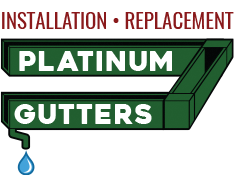Professional Gutter Replacement for the Keller & Flower Mound Areas
If you notice your gutter system is functioning improperly, it’s time to contact Platinum Gutters for replacement services in Keller, Flower Mound, and surrounding areas. We’ll start with a complimentary evaluation to assess your home’s gutter system replacement needs. Even if you think you just have a small leak, don’t wait for a big problem to call us. Keeping your gutter system in optimal functioning order is essential to ensuring the longevity of your gutters. Call us right away if you notice leaking, sagging, hanging sections or corners, rust, or poor drainage. We’ll get your gutter system back in proper working order to protect your home from foundational issues, landscaping damage, and other issues.
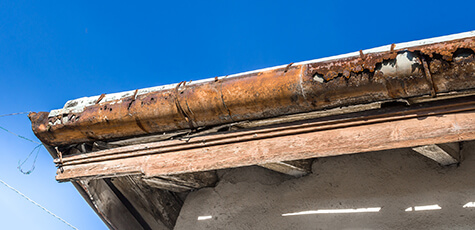 What to do About Rusty Rain Gutters
What to do About Rusty Rain Gutters
Rust only occurs on older, galvanized steel rain gutters. Rusty gutters do not allow water to drain away properly, and they negatively impact the appearance of your home. Seamless aluminum gutters will not rust, and they are significantly more affordable than galvanized steel. Other companies may tell you that rusted steel gutters can be fixed with pain or sealants, but in the long-run, replacing your steel gutters will likely save you money. Once your galvanized steel gutters begin to rust, the rust will spread. Sealants and paints only stop leaks caused by rust for a few months at most. While these short term solutions may seem like they save you money, your best financial option is likely to make the investment in an aluminum gutter system.
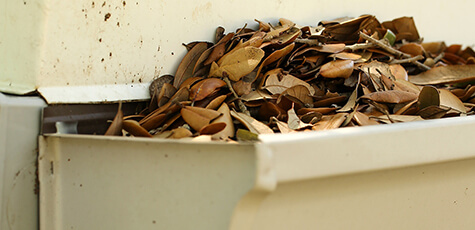 What to do About Overflowing or Clogged Gutter Systems
What to do About Overflowing or Clogged Gutter Systems
Keep an eye on your gutters during rain. If you ever notice rain overflowing the sides of your gutters, you may have a clog. Gutters can become clogged by any number of items including leaves, limbs, twigs, shingles, toys, bird nests, pests, and other debris. One small leave can lead to a severe clog as other debris is caught on it over time. Simply cleaning out the gutters using pressurized water may be adequate to remove the clog. If you clean your gutters and notice leaking, you will need to reseal them. To prevent clogging in the future, you may want to consider installing a gutter covers or leaf protectors to your existing gutter system.
Another cause of overflowing gutters is improper installation. This can be caused by placing the gutter system in front of the “drip edge,” placing too few, small, incorrectly placed and anchored downspouts, or using gutters that are too small. Proper drainage at the corners of the home essential. When water tries to move around the corner of the house, it slows and can lead to backup. Our custom gutter systems factor in all of these installation and placement systems.
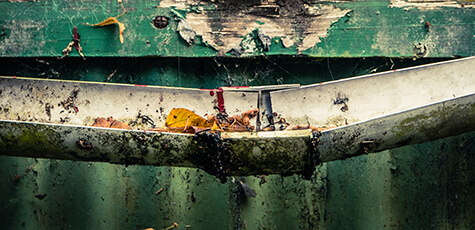 What to do About Loose, Falling, or Sagging Gutter Systems
What to do About Loose, Falling, or Sagging Gutter Systems
Loose or sagging gutters can be caused by a number of issues. One of the most common reasons we see gutters sagging is when the anchoring spikes and strips come loose. Changes in weather cause the gutters to move, and the holes where spikes connect the gutter to the fascia, straight board of material that connects directly to the underside of the roof, begin to be wear away becoming larger and allowing the gutter system to sag. Eventually, the spike will come completely away from fascia and the gutter system may fall.
Rather than relying solely on spikes to anchor the gutter system, we recommend hidden hanger brackets. These brackets are the preferred method for stabilizing gutter systems, but even this method may loosen over time if the screws are not long enough to provide adequate support. We use screws that are longer than the required industry standard in order to ensure our gutter systems don’t come loose. Additionally, we strictly obey the recommended placement of hanger brackets every two feet when installing or replacing guttering systems. Often, companies save installation time and material costs by increasing the space between anchors. Platinum Gutters stands behind their work, and will always strictly abide these standards.
Downspouts fall more frequently than other parts of gutter systems, and in almost every case where downspouts fall or become loose, the issue is with the method of attaching the straps that secure the downspout to the home. In brick homes, the issue typically occurs when the downspout is anchored into the mortar rather than the bricks. Mortar deteriorates much more quickly than other building materials, so it’s essential that the supportive straps not be connected to the mortar. Over time, the downspout can come lose and lead to leaks or sagging gutter systems.
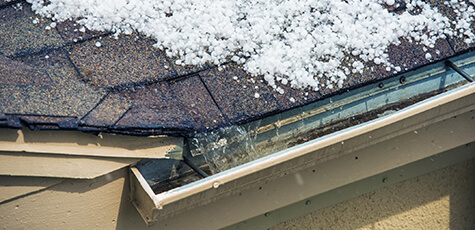 What to do About Hail Damage to Your Gutter System
What to do About Hail Damage to Your Gutter System
If you know where to look, spotting hail damage is pretty easy. After a hail storm, it’s important to walk the entire perimeter of your home looking for signs of damage to your gutters. You’ll want to look for dings or indentations in the metal. These dings can be on the outside of your gutter system or on the bottom of the gutters if the hail falls straight down to the bottom of the gutters. In extreme cases, hail can punch holes all the way through the guttering system. As long as there are not holes in the gutters, it’s likely that hail damage will only effect the appearance of your gutter system and not the actual function. Even if the function of your gutter hasn’t been negatively impacted, your home owners’ insurance policy will likely cover the cost of replacing your system.
Gutter Repair FAQs
What Are Some Common Causes of Gutter Damage?
Some of the most common causes of gutter damage include old age, clogged gutters, poor installation or materials, lack of cleaning/maintenance, heavy snow and ice, wind damage, water overflow, tree branches and debris, and animals and pests. When you opt to hire a professional service, they’ll be able to inspect your gutters and inform you of the extent of their damage, if any is present. Either way, understanding these causes can help you take the proper steps to prevent gutter damage and keep your gutters in great condition.
Why Are My Gutters Sagging?
Over time, your gutters can begin sagging and pulling away from your home. This usually occurs if your gutters haven’t been cleaned in a while and water has begun pooling in them; the added weight weakens the fascia, causing them to sink lower. The only solution for sagging gutters is to have the hardware replaced; you can’t simply bend or hold up the gutters once they’ve begun slumping. However, once the problem is fixed, it becomes relatively easy to prevent moving forward – just keep your gutters clean and clear!
Can Gutter Leaks Be Repaired?
Gutter leaks are fairly simple to locate; one of the easiest ways to look for them is to check for dripping water while you clean out your gutters – which you should be doing at least once every year anyway. If left unaddressed, leaks can cause damage to your roof, siding, and foundation, leading to costly repairs. Leaky gutters can be fixed by removing the deteriorated sealant and/or sealing holes with caulk, from the inside. If the holes are too big or the area around them has become rusted, you might need to replace that segment of the gutter entirely.
Can You Reposition or Relocate My Existing Downspouts?
The whole purpose of your gutters is to prevent water from collecting around your foundation, and for them to do this, the downspouts must be positioned far enough away from your home. If they’re too close, water will pool and cause damage. Before the next big storm in your area, you should make sure your downspouts extend at least two feet away from your home’s exterior. If they’re too close, don’t try to move them yourself, as you might damage them. Instead, call a professional gutter team to add extensions; this will ensure they have the extra length needed to keep runoff water away from your home.
Can My Existing Gutters Be Re-Pitched or Re-Sloped?
They sure can! Gutters need a slight pitch, or to be at a particular slope or angle, for rainwater to reach the downspouts and drain properly. Proper sloping ensures that all of the water will flow out of the system. If your gutter system doesn’t have a decent pitch, you’ll end up with standing water, which can cause your gutters to rust or sag, as well as attract pests. If you notice standing water in your gutters or water coming out of your downspout seems to wane, you should call a professional to have them check your pitch.
